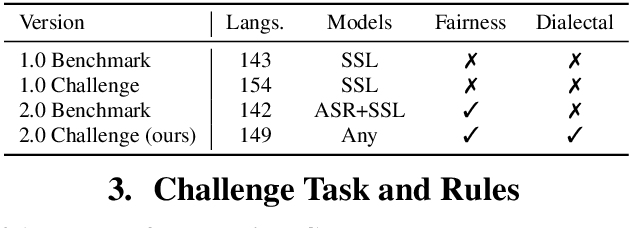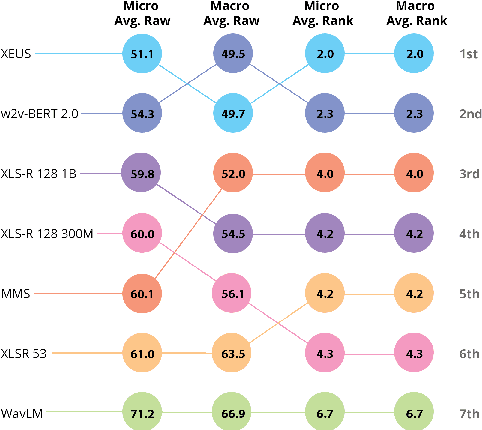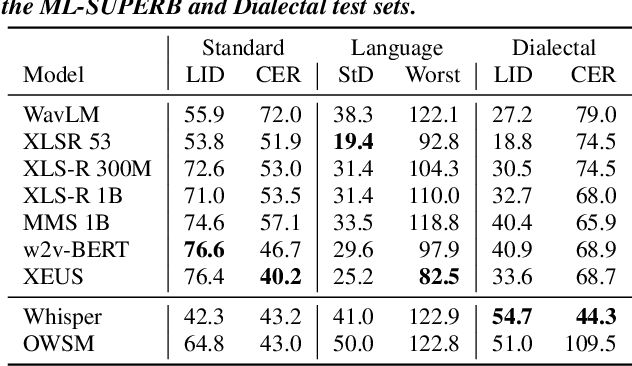Jiatong Shi
Full-Duplex-Bench-v2: A Multi-Turn Evaluation Framework for Duplex Dialogue Systems with an Automated Examiner
Oct 09, 2025Abstract:While full-duplex speech agents enable natural, low-latency interaction by speaking and listening simultaneously, their consistency and task performance in multi-turn settings remain underexplored. We introduce Full-Duplex-Bench-v2 (FDB-v2), a streaming framework that integrates with an automated examiner that enforces staged goals under two pacing setups (Fast vs. Slow). FDB-v2 covers four task families: daily, correction, entity tracking, and safety. We report turn-taking fluency, multi-turn instruction following, and task-specific competence. The framework is extensible, supporting both commercial APIs and open source models. When we test full-duplex systems with FDB-v2, they often get confused when people talk at the same time, struggle to handle corrections smoothly, and sometimes lose track of who or what is being talked about. Through an open-sourced, standardized streaming protocol and a task set, FDB-v2 makes it easy to extend to new task families, allowing the community to tailor and accelerate evaluation of multi-turn full-duplex systems.
SingMOS-Pro: An Comprehensive Benchmark for Singing Quality Assessment
Oct 02, 2025Abstract:Singing voice generation progresses rapidly, yet evaluating singing quality remains a critical challenge. Human subjective assessment, typically in the form of listening tests, is costly and time consuming, while existing objective metrics capture only limited perceptual aspects. In this work, we introduce SingMOS-Pro, a dataset for automatic singing quality assessment. Building on our preview version SingMOS, which provides only overall ratings, SingMOS-Pro expands annotations of the additional part to include lyrics, melody, and overall quality, offering broader coverage and greater diversity. The dataset contains 7,981 singing clips generated by 41 models across 12 datasets, spanning from early systems to recent advances. Each clip receives at least five ratings from professional annotators, ensuring reliability and consistency. Furthermore, we explore how to effectively utilize MOS data annotated under different standards and benchmark several widely used evaluation methods from related tasks on SingMOS-Pro, establishing strong baselines and practical references for future research. The dataset can be accessed at https://huggingface.co/datasets/TangRain/SingMOS-Pro.
Chain-of-Thought Reasoning in Streaming Full-Duplex End-to-End Spoken Dialogue Systems
Oct 02, 2025Abstract:Most end-to-end (E2E) spoken dialogue systems (SDS) rely on voice activity detection (VAD) for turn-taking, but VAD fails to distinguish between pauses and turn completions. Duplex SDS models address this by predicting output continuously, including silence tokens, thus removing the need for explicit VAD. However, they often have complex dual-channel architecture and lag behind cascaded models in semantic reasoning. To overcome these challenges, we propose SCoT: a Streaming Chain-of-Thought (CoT) framework for Duplex SDS, alternating between processing fixed-duration user input and generating responses in a blockwise manner. Using frame-level alignments, we create intermediate targets-aligned user transcripts and system responses for each block. Experiments show that our approach produces more coherent and interpretable responses than existing duplex methods while supporting lower-latency and overlapping interactions compared to turn-by-turn systems.
The Singing Voice Conversion Challenge 2025: From Singer Identity Conversion To Singing Style Conversion
Sep 19, 2025Abstract:We present the findings of the latest iteration of the Singing Voice Conversion Challenge, a scientific event aiming to compare and understand different voice conversion systems in a controlled environment. Compared to previous iterations which solely focused on converting the singer identity, this year we also focused on converting the singing style of the singer. To create a controlled environment and thorough evaluations, we developed a new challenge database, introduced two tasks, open-sourced baselines, and conducted large-scale crowd-sourced listening tests and objective evaluations. The challenge was ran for two months and in total we evaluated 26 different systems. The results of the large-scale crowd-sourced listening test showed that top systems had comparable singer identity scores to ground truth samples. However, modeling the singing style and consequently achieving high naturalness still remains a challenge in this task, primarily due to the difficulty in modeling dynamic information in breathy, glissando, and vibrato singing styles.
The ML-SUPERB 2.0 Challenge: Towards Inclusive ASR Benchmarking for All Language Varieties
Sep 08, 2025



Abstract:Recent improvements in multilingual ASR have not been equally distributed across languages and language varieties. To advance state-of-the-art (SOTA) ASR models, we present the Interspeech 2025 ML-SUPERB 2.0 Challenge. We construct a new test suite that consists of data from 200+ languages, accents, and dialects to evaluate SOTA multilingual speech models. The challenge also introduces an online evaluation server based on DynaBench, allowing for flexibility in model design and architecture for participants. The challenge received 5 submissions from 3 teams, all of which outperformed our baselines. The best-performing submission achieved an absolute improvement in LID accuracy of 23% and a reduction in CER of 18% when compared to the best baseline on a general multilingual test set. On accented and dialectal data, the best submission obtained 30.2% lower CER and 15.7% higher LID accuracy, showing the importance of community challenges in making speech technologies more inclusive.
Improving Speech Enhancement with Multi-Metric Supervision from Learned Quality Assessment
Jun 13, 2025Abstract:Speech quality assessment (SQA) aims to predict the perceived quality of speech signals under a wide range of distortions. It is inherently connected to speech enhancement (SE), which seeks to improve speech quality by removing unwanted signal components. While SQA models are widely used to evaluate SE performance, their potential to guide SE training remains underexplored. In this work, we investigate a training framework that leverages a SQA model, trained to predict multiple evaluation metrics from a public SE leaderboard, as a supervisory signal for SE. This approach addresses a key limitation of conventional SE objectives, such as SI-SNR, which often fail to align with perceptual quality and generalize poorly across evaluation metrics. Moreover, it enables training on real-world data where clean references are unavailable. Experiments on both simulated and real-world test sets show that SQA-guided training consistently improves performance across a range of quality metrics.
Discrete Audio Tokens: More Than a Survey!
Jun 12, 2025Abstract:Discrete audio tokens are compact representations that aim to preserve perceptual quality, phonetic content, and speaker characteristics while enabling efficient storage and inference, as well as competitive performance across diverse downstream tasks.They provide a practical alternative to continuous features, enabling the integration of speech and audio into modern large language models (LLMs). As interest in token-based audio processing grows, various tokenization methods have emerged, and several surveys have reviewed the latest progress in the field. However, existing studies often focus on specific domains or tasks and lack a unified comparison across various benchmarks. This paper presents a systematic review and benchmark of discrete audio tokenizers, covering three domains: speech, music, and general audio. We propose a taxonomy of tokenization approaches based on encoder-decoder, quantization techniques, training paradigm, streamability, and application domains. We evaluate tokenizers on multiple benchmarks for reconstruction, downstream performance, and acoustic language modeling, and analyze trade-offs through controlled ablation studies. Our findings highlight key limitations, practical considerations, and open challenges, providing insight and guidance for future research in this rapidly evolving area. For more information, including our main results and tokenizer database, please refer to our website: https://poonehmousavi.github.io/dates-website/.
DiscoSum: Discourse-aware News Summarization
Jun 07, 2025Abstract:Recent advances in text summarization have predominantly leveraged large language models to generate concise summaries. However, language models often do not maintain long-term discourse structure, especially in news articles, where organizational flow significantly influences reader engagement. We introduce a novel approach to integrating discourse structure into summarization processes, focusing specifically on news articles across various media. We present a novel summarization dataset where news articles are summarized multiple times in different ways across different social media platforms (e.g. LinkedIn, Facebook, etc.). We develop a novel news discourse schema to describe summarization structures and a novel algorithm, DiscoSum, which employs beam search technique for structure-aware summarization, enabling the transformation of news stories to meet different stylistic and structural demands. Both human and automatic evaluation results demonstrate the efficacy of our approach in maintaining narrative fidelity and meeting structural requirements.
ARECHO: Autoregressive Evaluation via Chain-Based Hypothesis Optimization for Speech Multi-Metric Estimation
May 30, 2025Abstract:Speech signal analysis poses significant challenges, particularly in tasks such as speech quality evaluation and profiling, where the goal is to predict multiple perceptual and objective metrics. For instance, metrics like PESQ (Perceptual Evaluation of Speech Quality), STOI (Short-Time Objective Intelligibility), and MOS (Mean Opinion Score) each capture different aspects of speech quality. However, these metrics often have different scales, assumptions, and dependencies, making joint estimation non-trivial. To address these issues, we introduce ARECHO (Autoregressive Evaluation via Chain-based Hypothesis Optimization), a chain-based, versatile evaluation system for speech assessment grounded in autoregressive dependency modeling. ARECHO is distinguished by three key innovations: (1) a comprehensive speech information tokenization pipeline; (2) a dynamic classifier chain that explicitly captures inter-metric dependencies; and (3) a two-step confidence-oriented decoding algorithm that enhances inference reliability. Experiments demonstrate that ARECHO significantly outperforms the baseline framework across diverse evaluation scenarios, including enhanced speech analysis, speech generation evaluation, and noisy speech evaluation. Furthermore, its dynamic dependency modeling improves interpretability by capturing inter-metric relationships.
Uni-VERSA: Versatile Speech Assessment with a Unified Network
May 27, 2025Abstract:Subjective listening tests remain the golden standard for speech quality assessment, but are costly, variable, and difficult to scale. In contrast, existing objective metrics, such as PESQ, F0 correlation, and DNSMOS, typically capture only specific aspects of speech quality. To address these limitations, we introduce Uni-VERSA, a unified network that simultaneously predicts various objective metrics, encompassing naturalness, intelligibility, speaker characteristics, prosody, and noise, for a comprehensive evaluation of speech signals. We formalize its framework, evaluation protocol, and applications in speech enhancement, synthesis, and quality control. A benchmark based on the URGENT24 challenge, along with a baseline leveraging self-supervised representations, demonstrates that Uni-VERSA provides a viable alternative to single-aspect evaluation methods. Moreover, it aligns closely with human perception, making it a promising approach for future speech quality assessment.
 Add to Chrome
Add to Chrome Add to Firefox
Add to Firefox Add to Edge
Add to Edge